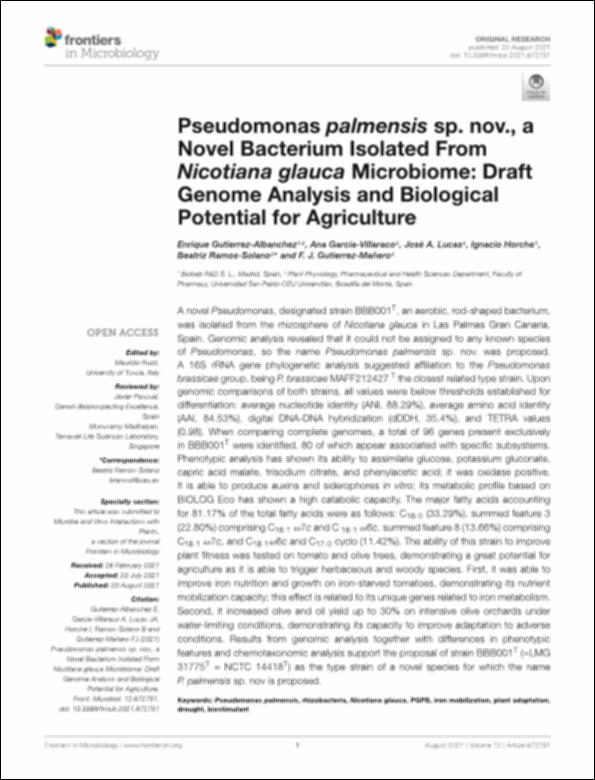Por favor, use este identificador para citar o enlazar este ítem:
http://hdl.handle.net/10637/15889Pseudomonas palmensis sp. nov., a Novel Bacterium Isolated From Nicotiana glauca Microbiome: Draft Genome Analysis and Biological Potential for Agriculture
| Título : | Pseudomonas palmensis sp. nov., a Novel Bacterium Isolated From Nicotiana glauca Microbiome: Draft Genome Analysis and Biological Potential for Agriculture |
| Autor : | Gutierrez-Albanchez, Enrique García Villaraco, Ana Lucas García, José Antonio Horche Trueba, Ignacio Ramos Solano, Beatriz Gutiérrez Mañero, Francisco Javier |
| Materias: | Plant adaptation; Drough; Biostimulant |
| Editorial : | Frontiers Media |
| Citación : | Gutierrez-Albanchez E, García-Villaraco A, Lucas JA, Horche I, Ramos-Solano B and Gutierrez-Mañero FJ (2021) Pseudomonas palmensis sp. nov., a Novel Bacterium Isolated From Nicotiana glauca Microbiome: Draft Genome Analysis and Biological Potential for Agriculture. Front. Microbiol. 12:672751. doi: 10.3389/fmicb.2021.672751 |
| Resumen : | A novel Pseudomonas, designated strain BBB001T , an aerobic, rod-shaped bacterium, was isolated from the rhizosphere of Nicotiana glauca in Las Palmas Gran Canaria, Spain. Genomic analysis revealed that it could not be assigned to any known species of Pseudomonas, so the name Pseudomonas palmensis sp. nov. was proposed. A 16S rRNA gene phylogenetic analysis suggested affiliation to the Pseudomonas brassicae group, being P. brassicae MAFF212427 T the closest related type strain. Upon genomic comparisons of both strains, all values were below thresholds established for differentiation: average nucleotide identity (ANI, 88.29%), average amino acid identity (AAI, 84.53%), digital DNA-DNA hybridization (dDDH, 35.4%), and TETRA values (0.98). When comparing complete genomes, a total of 96 genes present exclusively in BBB001T were identified, 80 of which appear associated with specific subsystems. Phenotypic analysis has shown its ability to assimilate glucose, potassium gluconate, capric acid malate, trisodium citrate, and phenylacetic acid; it was oxidase positive. It is able to produce auxins and siderophores in vitro; its metabolic profile based on BIOLOG Eco has shown a high catabolic capacity. The major fatty acids accounting for 81.17% of the total fatty acids were as follows: C16:0 (33.29%), summed feature 3 (22.80%) comprising C16:1 ω7c and C 16:1 ω6c, summed feature 8 (13.66%) comprising C18:1 ω7c, and C18:1ω6c and C17:0 cyclo (11.42%). The ability of this strain to improve plant fitness was tested on tomato and olive trees, demonstrating a great potential for agriculture as it is able to trigger herbaceous and woody species. First, it was able to improve iron nutrition and growth on iron-starved tomatoes, demonstrating its nutrient mobilization capacity; this effect is related to its unique genes related to iron metabolism. Second, it increased olive and oil yield up to 30% on intensive olive orchards under water-limiting conditions, demonstrating its capacity to improve adaptation to adverse conditions. Results from genomic analysis together with differences in phenotypic features and chemotaxonomic analysis support the proposal of strain BBB001T (=LMG 31775T = NCTC 14418T ) as the type strain of a novel species for which the name P. palmensis sp. nov is proposed. |
| Descripción : | Datos de investigación en la siguiente url: https://www.ncbi.nlm.nih.gov/bioproject/PRJNA705568 |
| URI : | http://hdl.handle.net/10637/15889 |
| Derechos: | http://creativecommons.org/licenses/by-nc-nd/4.0/deed.es Open Access |
| ISSN : | 1664-302X |
| Fecha de publicación : | 20-ago-2021 |
| Centro : | Universidad San Pablo-CEU |
| Aparece en las colecciones: | Facultad de Farmacia |
Los ítems de DSpace están protegidos por copyright, con todos los derechos reservados, a menos que se indique lo contrario.


